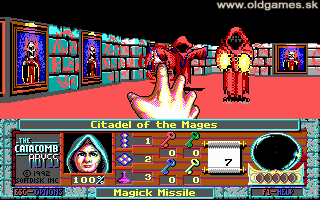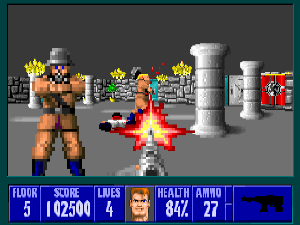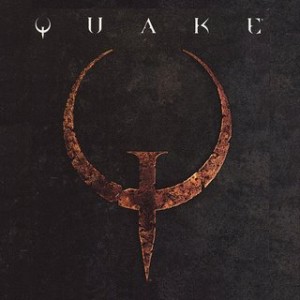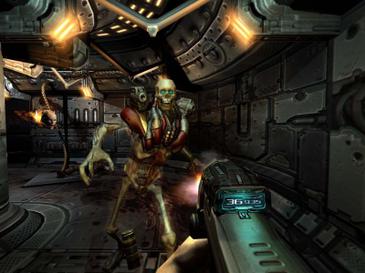In just a few short months gamers will be able to play the first AAA id Software game since Doom 3. Rage features the latest engine by master programmer John Carmack and game design by long time id designer Tom Willits. Now for those of us who remember the 90's, id's name means a lot. But for the younger generation of gamers here, the name means little to nothing. Some of you have probably never played Doom, Quake, or Wolfenstein. So I am here to help fill you in on the history of id Software so you'll be up to date when Rage is released later this year.
The Early Years
id Software was founded officially in 1991 by John Carmack, Tom Hall, Adrian Carmack (no relation to John), and John Romero. Of the four, only John Carmack still remains with the company 20 years later. The first game from id was Commander Keen. It was a 2D sidescrolling platformer created while the team still worked for a company called Softdisk. Commander Keen was the first PC game to make use of the smooth scrolling that was found in Nintendo's Mario games. It was Carmack's first major programming accomplishment. In addition the layered effect used in 2D sidescrolling games (called Parallax Scrolling) was also implemented on the PC for the first time. Tom Hall was the lead designer on Commander Keen and he was helped by John Romero. Adrian did the art, and John Carmack did the programming. The game was a moderate success. Keen was also one of the first games to be released through the "shareware" method. In essence, a gamer who wanted a shareware game could try a portion of the game for free, sort of like a modern demo, and then buy the remaining portion or portions of a game for money. Keen was split into three episodes, with the first being free and the following two costing money.
A sequel to Comandeer Keen was made which also had three episodes, although episode 6 was eventually released as a standalone game at brick and mortar stores as well. These 2D games laid the foundation for id Software's dedication to technical excellence, but they also featured very little in the way of gameplay innovation. The highlight was the work of John Carmack. Romero, Hall, and Adrian Carmack were second fiddle.

During the development of Keen, the members of id also had to fufill their contractual obligations to their former employer softdisk. In addition to making a Commander Keen game outside of the main series, id made Shadow Knights, a Ninja Gaiden style platformer, Slordax: The Unkown Enemy, Dangerous Dave and the Haunted Mansion, and Rescue Rover 1 and 2. Most likely you have never heard of these games, and you wouldn't be alone. They weren't very successful and I certainly never played them nor knew anyone who did.
The final games released for Softdisk were the most important from a technological and gameplay perspective. Hovertank 3D and Catacomb 3D were among the very first games released on PC with a 3D perspective. Catacomb 3D was arguably the very first first person shooter, or at least the basis for the first ones. The perspective shown in the game, with a hand stretched up from the bottom of the screen, became the basis for much of modern first person game design. The graphics tech was arguably based on the one that was at the time in development at Looking Glass Studios for Ultima Underworld, but Catacomb beat that game to the market even though development was started several years later.

Rise of the Shooter
In 1992 id Software released The Spear of Destiny. The prequel to the more famous Wolfenstein 3D, The Spear of Destiny took the first person perspective of Catacomb 3D and added a gun. The first person shooter had been born. It wouldn't be until later that year, though, that the genre took off. Released on May 5, 1992 Wolfenstein 3D took gamers by storm. Featuring the now classic structure that would be employed by id Software up to this day, Wolfenstein 3D had players search a level for a series of keys that would open doors that would eventually lead to an exit to the next level. It was a brilliant and unheard of formula. id was smart enough to include a kill count at the end of levels, and also created hidden areas for players to find. Additionally, treasure was strewn throughout every level for players to collect. All of this drove players to replay Wolfenstein 3D over and over to find every last treasure and secret area, and kill every last enemy.
There were limitations to Wolfenstein 3D though. There was no mouse support. Players could not look up or down, strafe, or jump. Enemies could only be placed on the same plane as the player. You couldn't have objects stacked on other objects, so no multi-story levels. It was a basic formula, but was at the time revolutionary, and is honestly still pretty fun to play today.

A year and a half later, on December 10, 1993, id Software released the legendary Doom. Featuring more violence, more weapons, and a much more interesting premise, Doom took the world by storm. Politicians and parent watch groups went crazy. Doom was branded as the anti-christ. Along with Mortal Kombat is helped bring game violence to the forefront of parent's minds worldwide. Oh and it was a ton of fun. The first person shooter was now a full blown genre and everyone wanted a piece of id's magic. Tom Hall lead the design team with John Romero, while Adrian once more did the art, and John Carmack did the programming. The tech used in the game is now known as id Tech 1. This tech would be licensed by Raven Software to create Heretic, a fantasy first person shooter, and it's semi-sequel Hexen, as well as several other games.

A year later, on September 30, 1994, id released the sequel to Doom, Doom 2. The game used the same engine as the first game, but featured more enemies, more weapons, and some new effects. Both Doom games were massive hits, catapulting id to the forefront of game development, and cementing John Carmack's status as one of the greatest programmers in computer history. Doom 2 is notable because it is the first game developed by id after the exodus of lead designer Tom Hall. Taking over Hall's duties was American McGee, who would work on several games for id over the next several years.
The Rise of the Third Dimension
It took well over a year for John Carmack and team to create their next game. Released on June 22, 1996 Quake was Carmack's next major technological triumph. The Quake engine was the first tech created by a game studio that allowed for entirely 3D gameplay. Previous engines had mixed 2D and 3D elements, but Quake featured fully polygonal characters, objects, and environments. Virtually every 3D game released since borrows some code from Carmack's engine. While Quake was a masterpiece from a technical standpoint, the gameplay was standard id fare. The single player involved collecting keys to get through doors to reach an exit. It all looked a lot better, but it didn't play a lot better. Quake's multiplayer mode featured the standard deathmatch scenarios seen in Doom, but added things like strafing and rocket jumping. With the advent of 3D players could now look in all directions with full mouse support. So while the level design remained the same, the controls improved and the technical innovations astounded.

id followed Quake with Quake II released a year and a half later on November 30, 1997. Quake II is not directly related from a story standpoint to the first game, and deals with an alien invasion and a counter-attack by a fleet of space marines against the invading aliens. Quake II was the first id game that tried to add a greater level of context to the action happening in the game. In previous id games, the story could only be gleaned through the manual or by reading about it online or in a print magazine. Quake II featured fully voiced cutscenes which brought the story to life. The graphics were vastly improved from the first game. At the time they were among the most impressive seen on any system. The important thing to note, though, is that the gameplay once again remained stagnant. Yes the controls were improved and the multiplayer was easier to get into, and so forth, but the single player still involved opening doors to get to an exit. There was a greater degree of window dressing here, with buttons to push and computers to program and such, but it all still boiled down to finding a key and opening a door until you found the exit. By this time other games had started pushing level design in new and exciting directions, and the very standard levels present here were starting to show their age.
id rounded out the 90's with Quake 3. By this time much of the initial staff at id had left the company. John Romero and American McGee had both left to pursue other interests. Tom Willits was now design director. Adrian Carmack was still doing art, and John Carmack was still toiling away on the engines. The newest engine was called id Tech 3. Quake 3 did not have a single player component and instead focused on multiplayer modes. Deathmatch was once again the most popular and Quake 3 featured large maps, fast movements, and big weapons. The online following became massive, and the game was recently rereleased as a browser game and on Xbox Live. Along with Unreal Tournament, Quake 3 brought online deathmatch to the masses.
A New Generation
id wouldn't release a new game for five years after the release of Quake 3. The small team was hard at work on a new vision for a classic series. Doom 3, released on August 3, 2004, used the latest graphical tech. It was among the first games to use bump mapping and ambient lighting. It looked better than any other game released at the time, and honestly still looks good now, 7 years later. Doom 3 was the last id game to feature the art of Adrian Carmack, who left the company soon after the game was released. Doom 3 was an intense game, the first attempt at true horror for id. While it was a success, id's ancient design principles were starting to catch up with them. Doom 3 had fully voiced cutscens, actual characters that the player could interact with, and missions that on the surface seemed far removed from the key collecting of past id games. But when you get down to it, Doom 3 was simply a much better looking version of the game that id had been making for over 10 years. With Far Cry, Max Payne 2, Half Life 2, Halo 2, and more all released in the same year, shooters were evolving and changing. Doom 3 was more technically accomplished than any of those games, but it was still a corridor crawl from beginning to end, and by that point, the formula was starting to feel pretty old.

And that was the last AAA game that id has released. It's been seven years since then and id has released only mobile games. We've seen handheld versions of most of id's classic titles, as well as RPG versions of Wolfenstein and Doom. Orcs and Elves was the first new ip out of id since the release of Quake. That RPG was released on mobile phones and the DS. This year id returns to the spotlight. Rage features John Carmack's latest engine and hopefully updates the game's design to be more in line with modern titles. Many of you have probably never played an id game. Their legacy to you is a piece of history. Let's hope that Tom Willits and John Carmack can take things to the next level with Rage and take back their title as one of the greatest developers in video game history.
very nicely written. whenever there is any major id launch something like a revolution do come up in the gaming industry!!!
I honestly don't think there will be any WOW factor or anything revolutionary. And at this stage of gaming, to take it to another level, id needs more than just good history. But I'll still have my hopes on. Surprises are always good when they are most unpredicted.
WOW I didn't have any idea that id Software had contributed so much. I wasn't sure about purchasing Rage since it looked similar to Fallout, but now I certainly am.
@Dramus - I actually had never played Quake 1 and 2 until just a couple days before writing this blog. I got them and Quake 3 on the Steam sale for like $10. I had played Doom and Wolfenstein but never Quake. Dunno what honestly.
@Koshai - id pushes tech in ways few other companies do. As far as their actual game design goes, they only have made a couple notable contributions
@Amaya - Rage looks very promising. I don't think it will be the game changer that past id games have been, but I bet it will be a damn good shooter.
@Sleven - Rage is a shooter. Fallout is an RPG. They have a similar setting but the gameplay is quite different.
I'm glad that you agree. Until and unless we get Xbox 720 or PS4, I don't thing any game will change the course of our current generation of games. And as long as there are zombies in any game, it has to be a good shooter ;)
@Amaya - I think graphically it will be one of the best looking games of this generation. Honestly, having a game that looks that good run at 60 fps is easily the greatest technological feat ever accomplished on current gen consoles. For example, the only other major shooter that has a target 60 fps is Call of Duty, but that game runs at 640p on 360 and even less on PS3 and it actually runs at more like 50 fps on 360 and 45 on PS3. If id can manage a true 60 fps in a shooter on current gen systems it would be a first as far as I know. And to have among the best looking games yet released on any system on top of that, well whatever you may say about the game itself, John Carmack still has the magic touch.
There are so many other games at 60fps. Street Fighter IV, Dantes Inferno, Super Meat Boy,GT5, Kane & Lynch Dog Days, GOW3, Wipeout HD and more. But I got your point, a combination of good graphics with 60fps gameplay would make the difference. As for Carmack, he did pretty good with Wolfenstein but not as good as you would expect from his quality.
niiiiceee that actually took me very far down memory lane lol. Quake must have been one of the first shooters i played *mumble mumble with god mode turned on mumble mumble*